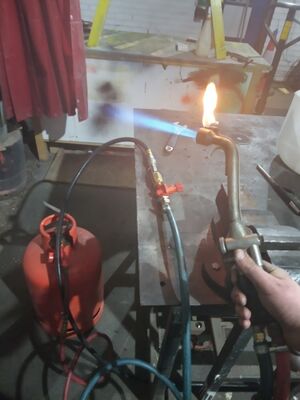Propane + Air Torch (Flamefast T4)
A large-scale torch intended primarily for brazing, but it can also be used for other heating tasks such as heat-treating or hot bending. This is a heavy-duty torch, the lighter Sievert torch gives better control on small jobs.
The torch requires brief training before use and so is kept in the fab shop - please return it after use. Current trainer is Toby Molyneux (HS32098)
Requires Propane fuel, see link for details
This torch works on a combination of propane gas and compressed air from the hackspace air compressor. Detailed instructions for safe setup will be given during training. The ideal pressure on the air regulator is about 0.8 bar although this should be adjusted to suit.
Although it produces a very large volume of heat this torch will not reach as high a temperature as oxy-acetylene so cannot be used for gas welding. Because it uses air rather than pure oxygen as a mixer gas it cannot be used for oxyfuel cutting.
This torch was salvaged from the hackspace's old broken brazing hearth. It has been adapted to run on on bottled propane and air from the compressor tank using some regulators belonging to Toby Molyneux. He will occasionally need to borrow these back for use on other appliances - if needed he would be happy to buy and configure some more if the hackspace wanted a set of its own
Risk Assessment - Welding
This risk assessment is intended to provide guidance on the risk associated with the above equipment and activities in normal use. Please also check general risk assessments for the space as a whole. Any discrepancies, errors or concerns should be raised with the document maintainers or trustees - do not edit this assessment directly. For responsible persons and last update, see 'version log' of the assessment page.
Activity
Welding of metals via any electric process (MIG, TIG or MMA/Stick)
Signage
Understanding Risk Rating
LOW - Ensure current control measures are in place and continue with activity
MED - Control measures may be adequate, co-supervision is recommended
HIGH - Do not undertake activity without further consultation with area specialists
Risk Assessment
| Identify Hazards | Who May be Harmed and How | Severity | Control Measures | Likelihood | Risk Rating |
|---|---|---|---|---|---|
| Radiation from light and heat. | Users | High | Operators are competent in the use of the welding equipment. Full welding masks with a full UV and IR light filter are to be worn during all welding work. Welders flash can cause blindness and affect eyesight. Fire retardant gloves are to be worn. Hot material is to be treated with care and watched until sufficiently cool as not to pose a fire risk. All material must be fully secured in place using appropriate clamps to earth before the weld commences. If the equipment is not in satisfactory working order it should not be used. | Medium | Medium |
| Slips Trips and Falls | Users, Bystanders | Medium | Wear shoes or boots with non-slip soles, in particular in wet or snowy weather – make sure excessive wet isn’t tracked into the space. Ensure that good standards of housekeeping are maintained at all times, cables and other equipment will be managed so as not to cause a trip hazard. | Medium | Low |
| The light emitted by the weld can be dangerous to others who look directly at the it. | Bystanders | High | Screens must be put in place to protect others in the area. Welding tools will not be left unattended. The area will be made safe at the end of each session. | Medium | Low |
| Fire from Hot Work | Users, bystanders, public | High | It should be ensured that there is no combustible material in close proximity to the work. Suitable protection should be provided for any combustible items that cannot be moved and for combustible construction such as wooden worktops. A check should be carried out on all of the surrounding areas to minimise the possibility of ignition by heat transfer. Fire extinguishers are be provided in the space. Hot work’ should be stopped at the specified time before leaving the space. A thorough inspection of the area should be undertaken once the work is complete after completion. Where necessary, a further check should be carried out before leaving the space. Welding rods are to be cooled in a water filled bucket before disposal, or placed in a sand bucket, not discarded. | Medium | Medium |
| Use of gas bottles, leaks and high pressure discharge. | Users, bystanders, public | High | Bottles must be secured in the upright position, preferably on a trolley to aid mobility. All gauges, hoses, bagging and torches must be examined before use, any faulty equipment must be repaired or replaced prior to use. | Medium | Low |






